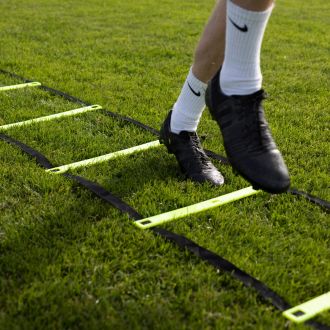7 Muscle Groups All Footballers Should Stretch Before Playing
The nature of football puts a huge amount of strain on specific muscle groups. If these muscles aren’t properly warmed and stretched beforehand, the consequences can be severe. Pulls, strains and tears can keep footballers out of action for months — so a stringent warm-up schedule before every match and training session is vital.
Whether you’re a seasoned campaigner or someone who plays for fun, these warm-ups should help to minimise the rise of serious muscle injury.
1. Quads
Once you’ve had a very gentle jog to get the blood pumping, your first warm-up routine should involve your quads. Using a teammate’s shoulder for support, grab your left foot and slowly pull it into your behind. You should feel your quad muscle stretching. Repeat this five times, and then switch to the other leg.
2. Hip flexors
Start on both knees. Move your left leg forward until your foot is planted on the floor in front of you, a little like a lunge from the kneeling position. Gently push forward through your left leg, and gently return to the starting position. Perform this warm-up five times, and then switch legs.
An alternative stretch for the hips is the lunge — with a twist. Perform a series of lunges, but after each one, swivel to one side while keeping your legs perfectly straight. This exercise works on your hips, as well as your quads and glutes. When you twist, the upper and middle back is getting a warm-up too.
3. Calves
Footballers are at a particularly high risk of calf strain due to the sharp twists and turns involved in the game. To ensure your calves are ready for action, lean against a teammate so you’re standing at an angle. With your left foot around two feet in front of your right, gently bend the left knee and straighten your entire right leg. Push down through your left leg while keeping the right perfectly straight, and you should feel your calf stretch. Perform this five times and then switch legs.
4. Groin and inner thigh
Sit on the floor with your knees pointing either side of you, and place the souls of your feet against one another. Very slowly and gently, grab your feet and pull them towards you. This is often called the butterfly stretch, and targets the muscles in both the inner thigh and the groin.
5. Hamstrings
Perhaps the most complex muscle injury most footballers endure during their career is a hamstring tear. Unfortunately, there is very little that can be done to correct the issue other than rest it. To minimise the risk of spending up to three months on the sidelines with a hamstring problem, you should stretch them before every match and training session. Simply sit on the floor with your legs stretched out in front of you. Grab both feet, and very gently rock back and forth.
Another good warm-up exercise for the hamstrings is the knee kick-out. Stand upright and lift your leg up as far as you can with the knee bent. Quickly take the foot back to the ground, and you should be able to feel your hamstring working.
6. Achilles tendon
Achilles tendons are relatively strong, but they can become susceptible to rupture if they’re not used regularly and kept in good shape. While an achilles is not a muscle, it needs to be stretched in the same way. Rest against a teammate, and stretch your left leg behind you, planting your left foot flat on the ground. Bend your right need forwards, while keep your left foot flat. Perform this five times, and switch to the other leg.
7. Groin
Moving forward, raise each leg in turn and then fan it out to your side. This is called “opening the gate” and it’s an exercise you will see professional footballers perform a lot during pre-match warm-up routines. Perform the same exercise with your bent leg starting from the outside, which is called “closing the gate”.
It’s important to stretch your main muscle groups before every period of exercise — whether you’re training or preparing for competition. Failure to follow a good warm-up routine every time could increase the risk of serious injury.





